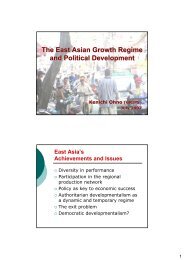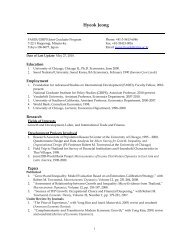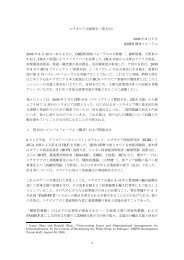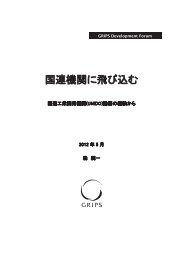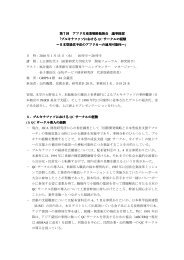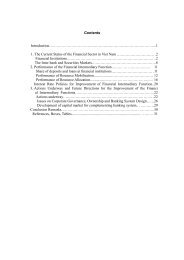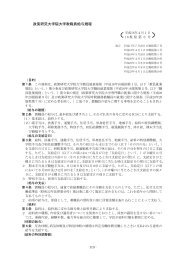this analysis, especially the estimation of TFP. In sett<strong>in</strong>g the region dummies, we use the classification ofregions used <strong>in</strong> the survey. In this survey, there are five regions <strong>in</strong>to which firms are classified: Red RiverDelta, Southern Central Costal, South East, Mekong River Delta and Northern Central. All these dummies arealso summarized <strong>in</strong> Table 2.V. RESULTS AND DISCUSSIONTable 3 describes differences between exporters and non-exporters <strong>in</strong> a range of characteristics. The firstcolumn lists the characteristics <strong>in</strong> which the differences are exam<strong>in</strong>ed. The second and fourth columns reportthe simple exporter premium and the conditional exporter premium, respectively. The simple exporterpremium is the percentage difference between exporters and non-exporters <strong>in</strong> the mean <strong>level</strong> of thecharacteristic <strong>in</strong> consideration, without controll<strong>in</strong>g for differences <strong>in</strong> other characteristics, <strong>in</strong>dustry or locationof firms. The conditional exporter premium is also the difference <strong>in</strong> the mean <strong>level</strong> but is calculated with othercharacteristics, location and <strong>in</strong>dustry type of firms be<strong>in</strong>g controlled for. The third and fifth columns list thecorrespond<strong>in</strong>g standard errors and t-statistics of these differences. At the unconditional mean, revenue andemployment <strong>level</strong>s <strong>in</strong> export<strong>in</strong>g firms are about 300 per cent greater than those <strong>in</strong> non-exporters. Exporters’capital scale is also larger, around 230 per cent. The positive premium of exporters <strong>in</strong> the conditional mean<strong>level</strong>s of these characteristics rema<strong>in</strong> the same, although the magnitudes are smaller. All these differences arestatistically significant at 1 percent <strong>level</strong>, imply<strong>in</strong>g that exporters are significantly larger than non-exporters.Exporters also have high premium <strong>in</strong> total factor productivity over non-exporters, about 28.7 and 16.4 percent for the simple and the conditional, respectively. However, the table shows that exporters have lowervalue added per worker. This difference <strong>in</strong> labor productivity is not large, and even statistically <strong>in</strong>significantfor the <strong>level</strong> <strong>in</strong> simple mean. Exporters appear to use labor-<strong>in</strong>tensive technology. The ratio of capital perworker of exporters is 20 and 45 per cent lower than that of non-exporters when compar<strong>in</strong>g <strong>in</strong> the simple andconditional means, respectively. Exporters appear to pay higher wage. However, this difference is notstatistically significant <strong>in</strong> both premium criteria. Related to years of experience <strong>in</strong> bus<strong>in</strong>ess, exporters areolder than non-exp orters. In summary, the data of the <strong>Vietnam</strong> PICS <strong>in</strong> 2005 hi nt that exporters <strong>in</strong>manufactur<strong>in</strong>g sector of <strong>Vietnam</strong> are “superior” to non-exporters <strong>in</strong> terms of size (employment, capital andrevenue), age and TFP. Besides, exporters appear to be <strong>in</strong>volved <strong>in</strong> more labor-<strong>in</strong>tensive production withlower value added per worker than their counterparts who solely serve the domestic market. There is nostatistically significant eviden ce for the difference <strong>in</strong> skills of workers employed by exporters andnon-exporters when skill is proxied by average wa ges.As argued <strong>in</strong> the previous sections, this superi ority of exporters, especially <strong>in</strong> TFP, at a givenmoment <strong>in</strong> time may be attributed to the self-sele ction <strong>in</strong>to markets of superior firms or to the positive effectof learn<strong>in</strong>g-by-export<strong>in</strong>g process. By exam<strong>in</strong><strong>in</strong>g the results of the estim ation of equation (14) which we report<strong>in</strong> Ta ble 4, we will be able to elaborate the determ <strong>in</strong>ants of the former when the latter is controlled for. In sixcolumns that go after the column of variables, we report estimated coefficients that represent the marg<strong>in</strong>aleffects of each explanatory variable on the value of the l<strong>in</strong>k function <strong>in</strong> probit models, i.e., on the value of the<strong>in</strong>verse of the standard normal cumulative distribution function (usually termed as the Z score) of theprobability to be an exporter. As it is well-known <strong>in</strong> probit models, it is complicated to <strong>in</strong>terpret the marg<strong>in</strong>aleffect directly on the probability of becom<strong>in</strong>g an exporter. Besides, it is not much important to report thiseffect when we use the data of a sample, not the whole population, of the firms. Therefore, we choose to focus18
on the analysis of the direction of this effect, <strong>in</strong> other words, the sign of parameter estimates. This sign is alsothat of the marg<strong>in</strong>al effects on the Z score that we report <strong>in</strong> Table 4.Table 3:DIFFERENCES BETWEEN EXPORTERS AND NON-EXPORTERSSimpleConditionalStandard errorsVariables ExporterExporterStandard errorsPremium (%)Premium (%)Revenue 285.38 0.0669 *** 51.55 0.0384 ***TFP 28.66 0.0613 *** 16.39 0.0408 ***Labor Productivity -1.91 0.0418 -11.52 0.036 ***Employment 313.80 0.0496 *** 158.56 0.0521 ***Average Wage 3.29 0.0281 4.50 0.0283Capital 227.52 0.0736 *** 150.58 0.0726 ***Capital Intensity -20.05 0.0556 *** -44.68 0.0405 ***Age 33.17 0.0466 *** 14.57 0.0527 **Note:*** , ** , and * <strong>in</strong>dicate significance at 1%, 5%, and 10% <strong>level</strong>s, respectively.The first three columns of Table 4 list the estimated parameters <strong>in</strong> estimations that <strong>in</strong>clude thenatural logarithm of TFP <strong>in</strong> the vector of explanatory variables, and the last three present the results ofregressions that use the natural logarithm of labor productivity <strong>in</strong> the place of the logarithm of TFP. Themodels (1) and (4) are probit <strong>in</strong> pooled data; (2) and (5) the Heckman’s random-effects dynamic probit; and(3) and (6) the random-effects probit <strong>in</strong> the sample of non-status-switchers. We do not list the parameterestimates of <strong>in</strong>dustry and region dummies <strong>in</strong> Table 4 and refer readers to the full results <strong>in</strong> Table A.2 <strong>in</strong> theAppendix.We are now first to <strong>in</strong>terpret the estimation results described <strong>in</strong> Table 4, and then to raise somecomments on important po<strong>in</strong>ts of these results. It shows <strong>in</strong> Table 4 that the most important determ<strong>in</strong>ant is theexport<strong>in</strong>g experience. Export<strong>in</strong>g last year is a good predictor of export<strong>in</strong>g this year. Be<strong>in</strong>g an exporter <strong>in</strong> theprevious period raises the Z score by more than 320 per cent <strong>in</strong> the poole d probit specifications. As expla<strong>in</strong>ed<strong>in</strong> the empirical background, this <strong>level</strong> is the upper bound of the parameter estimate due to the upward bias ofthe estimations us<strong>in</strong>g pooled data without co ntroll<strong>in</strong>g for unobserved firm effects. Howev er, the positiverelation is still seen <strong>in</strong> our preferred estimation <strong>in</strong> Heckman’s random-effects dynamic probit specifications.The marg<strong>in</strong>al effect on the Z score rema<strong>in</strong>s high at about 200 per cent, two thirds of the upper bound. Thisimportant effect of past behavior <strong>in</strong> export<strong>in</strong>g is usuall y <strong>in</strong>terpreted as the evide nce of sunk en try costs, ash<strong>in</strong>ted <strong>in</strong> the theoretical background.However, there is no statistically significant evidence that firms <strong>in</strong> <strong>Vietnam</strong> with higher TFP <strong>level</strong>self-select <strong>in</strong>to serv<strong>in</strong>g foreign mar kets. In the regression us<strong>in</strong>g the p ooled data se t, the effect o f the logarithmof TFP last year on the Z score th is year is negative at the significance <strong>level</strong> of 10 per cent. Th is implies thereis a negative relationship between TFP <strong>level</strong> <strong>in</strong> the previous year and the likelihood to be an exporter this year.This effect becomes statistically <strong>in</strong>significant, tho ugh still negative, <strong>in</strong> the dynamic random-effectsspecification whose results are rep orted <strong>in</strong> column (2). When we exclude the laggeddependent variable <strong>from</strong>19



